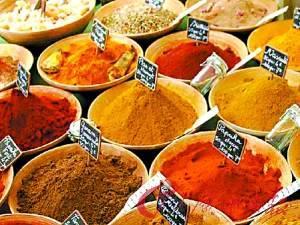 The spice buds also contain very good amounts of vitamin A and beta-carotene . These compounds are known to have antioxidant properties. Vitamin A is also required by the body for maintaining healthy mucus membranes and skin and is essential for good vision. Consumption of natural foods rich in flavonoids helps to protect the body from lung and oral cavity cancers.
The spice buds also contain very good amounts of vitamin A and beta-carotene . These compounds are known to have antioxidant properties. Vitamin A is also required by the body for maintaining healthy mucus membranes and skin and is essential for good vision. Consumption of natural foods rich in flavonoids helps to protect the body from lung and oral cavity cancers.Additionally, this spice is a good source of vitamin-K, vitamin-B6 (pyridoxine), thiamin (vitamin B-1), vitamin-C and riboflavin. Consumption of foods rich in vitamin C helps the body develop resistance against infectious agents and scavenge harmful oxygen-free radicals.
Cloves (Sygizium aromaticum), Nutritive Value per 100 g (Source: USDA National Nutrient data base)
| Principle | Nutrient Value | Percentage of RDA |
| Vitamins | ||
| Folates | 68 µg | 17% |
| Niacin | 1.046 mg | 6.50% |
| Pantothenic acid | 0.338 mg | 7% |
| Pyridoxine | 0.116 mg | 9% |
| Riboflavin | 0.066 mg | 5% |
| Thiamin | 0.072 mg | 6% |
| Vitamin A | 13 IU | 0.50% |
| Vitamin C | 11.7 mg | 20% |
| Vitamin E | 0.19 mg | 1% |
| Vitamin K | 14.8 µg | 12% |
| Electrolytes | ||
| Sodium | 94 mg | 6% |
| Potassium | 370 mg | 8% |
| Minerals | ||
| Calcium | 44 mg | 4% |
| Copper | 0.231 mg | 27% |
| Iron | 1.28 mg | 16% |
| Magnesium | 60 mg | 15% |
| Manganese | 0.256 mg | 11% |
| Phosphorus | 90 mg | 13% |
| Selenium | 7.2 µg | 13% |
| Zinc | 2.32 mg | 21% |
Nutmeg
The aromatic spice, Nutmeg and its oil are being used in for illnesses related to the nervous and digestive systems since olden times.
It helps improve appetite, curing digestive problems, reducing flatulence, relaxing the muscles, controlling asthma, etc. Nutmeg contains active compounds that are known to have been anti-oxidant. Nutmeg has many therapeutic applications as anti-fungal, and anti-depressant. It contains minerals like copper, potassium, calcium, manganese, iron, zinc and magnesium.
The nutmeg oil is used as a local massage to reduce muscular pain and rheumatic pain of joints.
Nutmeg (Myristica fragrans), Ground form, Nutritional value per 100 g. (Source: USDA National Nutrient data base)
| Principle | Nutrient Value | Percentage of RDA |
| Vitamins | ||
| Folates | 76 µg | 19% |
| Niacin | 1.299 mg | 8% |
| Pyridoxine | 0.160 mg | 12% |
| Riboflavin | 0.057 mg | 4% |
| Thiamin | 0.346 mg | 29% |
| Vitamin-A | 102 IU | |
| Vitamin C | 3 mg | 5% |
| Electrolytes | ||
| Sodium | 16 mg | 1% |
| Potassium | 350 mg | 7.50% |
| Minerals | ||
| Calcium | 184 mg | 18% |
| Copper | 1.027 mg | 114% |
| Iron | 3.04 mg | 38% |
| Magnesium | 183 mg | 46% |
| Manganese | 2.900 mg | 126% |
| Phosphorus | 213 mg | 30% |
| Zinc | 2.15 mg | 20% |
Black pepper
Peppers have been in use since ancient times for its anti-inflammatory and anti-flatulent properties. They contain essential oil piperine, an amine alkaloid, which gives strong spicy pungent character to the pepper.
The active principles in the pepper may increase the gut motility as well as the digestion power by increasing gastro-intestinal enzyme secretions. It has also been found that piperine can increase absorption of selenium, B-complex vitamins, beta-carotene, as well as other nutrients from the food.
Black peppercorns contain a good amount of minerals like potassium, calcium, zinc, manganese, iron, and magnesium.
They are also an excellent source of many vital B-complex groups of vitamins such as Pyridoxine, riboflavin, thiamin and niacin.





